Morphological control of self-assembled multivalent (SAMul) heparin binding in highly competitive media†
Abstract
Tuning molecular structures of self-assembling multivalent (SAMul) dendritic cationic lipopeptides controls the self-assembled morphology. In buffer, spherical micelles formed by higher generation systems bind polyanionic heparin better than worm-like micelles formed by lower generation systems. In human serum, the binding of spherical micelles to heparin is adversely affected, while worm-like micelles maintain their relative binding ability.



 Please wait while we load your content...
Please wait while we load your content...